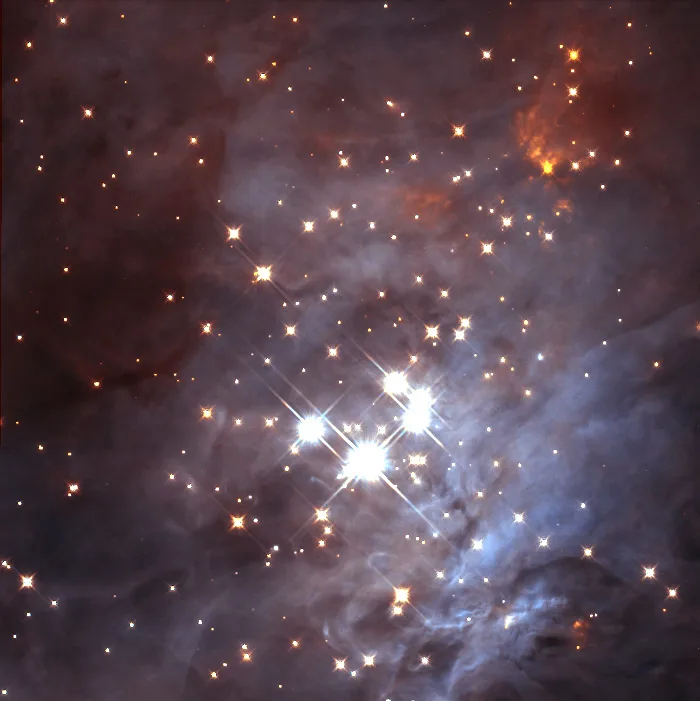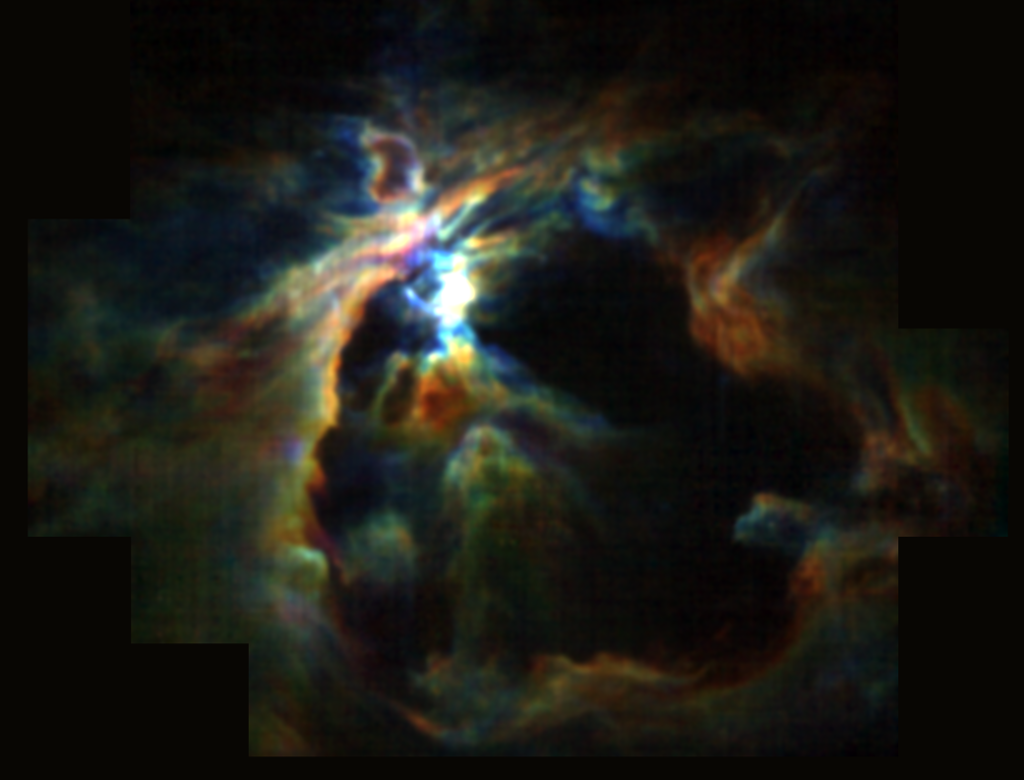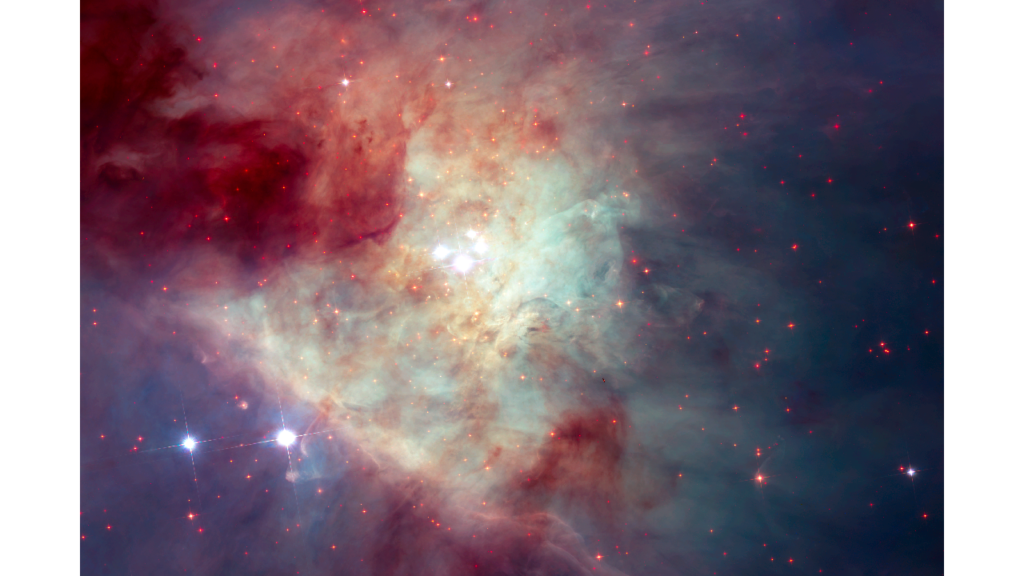The Celestial Nursery
© NASA/JPL-Caltech/Univ. of Toledo
The Orion Nebula, also known as Messier 42, M42, or NGC 1976, is a diffuse nebula situated in the Milky Way, located south of Orion’s Belt in the constellation of Orion. It is one of the brightest nebulae and is visible to the naked eye in the night sky with an apparent magnitude of 4.0. The nebula is 1,344 ± 20 light-years (412.1 ± 6.1 pc) away, making it the closest region of massive star formation to Earth.
The M42 nebula is estimated to be 24 light-years across, with an apparent size from Earth of approximately 1 degree. It has a mass of about 2,000 times that of the Sun. Older texts frequently refer to the Orion Nebula as the “Great Nebula in Orion” or the “Great Orion Nebula”.
The Orion Nebula is among the most scrutinized and photographed objects in the night sky and the most intensely studied celestial features. The nebula has revealed much about the process of how stars and planetary systems are formed from collapsing clouds of gas and dust. Astronomers have directly observed protoplanetary disks and brown dwarfs within the nebula, as well as intense and turbulent motions of the gas, and the photo-ionizing effects of massive nearby stars in the nebula.
STRUCTURE

The structure of the Orion Nebula is a complex and dynamic system, comprising various components that interact and influence each other. The nebula is a stellar nursery, where new stars are forming from interstellar gas and dust. The structure of the Orion Nebula can be broken down into several key features:
MAIN IONIZATION FRONT
The Main Ionization Front in the Orion Nebula is a crucial boundary where the hot, diffuse interior of the nebula meets a dense, cool cloud. This region is marked by intense ultraviolet light emitted by a cluster of hot and luminous stars, particularly the Trapezium stars. The Main Ionization Front plays a significant role in shaping the structure and dynamics of the nebula, with sharp boundaries and features likely caused by shocks from outflows originating in the Orion-S star formation region. Understanding the Main Ionization Front is essential for unraveling the intricate processes of star formation and the interactions between ionized gas and cooler, denser material within the nebula.
FOREGROUND LID
The Foreground Lid in the Orion Nebula, also known as the “foreground lid” to M42, is a significant component that plays a crucial role in the nebula’s structure. This layer of neutral hydrogen (H I) is observed in absorption lines and optical spectra, impacting the way we perceive the nebula. The Foreground Lid is believed to be part of a larger complex of gas and dust, distinct from the main ionization front, influencing the spectral intensities and introducing absorption and scattering effects. Understanding the Foreground Lid is essential for comprehending the intricate interactions between different regions within the Orion Nebula and how they contribute to its overall dynamics and appearance.
DARK BAY
The Dark Bay is a prominent feature within the Orion Nebula, extending from the north into the bright region. It is characterized by a high density of gas and dust, which absorbs and scatters light, making it appear dark compared to the surrounding areas.
Observations have revealed that the Dark Bay has a mass of about 3 solar masses and possesses numerous small knots of material, in addition to a curved ridge structure that resembles a bow shock. This feature is believed to be part of the foreground lid, a layer of neutral hydrogen that lies in front of the main ionization front and affects how we observe the nebula. The Dark Bay is a significant component of the Orion Nebula’s complex structure, providing insights into the interactions between the hot, ionized gas and the cooler, denser material within this stellar nursery.
TRAPEZIUM STARS
The Trapezium stars are a cluster of four massive, hot, and luminous stars at the heart of the Orion Nebula. These stars, designated as Theta1 Orionis A, B, C, and D, are the primary source of energy that ionizes the surrounding gas, creating the vibrant colors and structures we observe in the nebula.
The Trapezium stars are estimated to be between 15 to 30 times the mass of the Sun, and they are located within a diameter of just 1.5 light-years of each other. The brightest of the four, Theta1 Orionis C, has an apparent magnitude of 5.13 and is one of the most luminous stars known, emitting over 250,000 times the energy of the Sun. The Trapezium stars play a crucial role in shaping the structure and dynamics of the Orion Nebula through their intense ultraviolet radiation and stellar winds.
MOLECULAR CLOUD COMPLEX
The Orion Nebula is part of a larger molecular cloud complex, which includes the Orion Molecular Cloud (OMC-1) and other components. This complex is a vast region of gas and dust that spans hundreds of light-years and is one of the most intense regions of star formation in our galaxy.
The molecular cloud complex provides the raw material for star formation, with the Orion A and Orion B clouds being the most active star-forming regions. These clouds contain thousands of young stellar objects, including protostars and pre-main sequence stars. The structure and dynamics of the molecular cloud complex play a crucial role in shaping the Orion Nebula and the ongoing processes of star birth within this stellar nursery.
CHARACTERISTICS

VISIBILITY AND LOCATION
- The Orion Nebula is visible to the naked eye even in areas affected by light pollution.
- It appears as the middle “star” in the “sword” of the Orion constellation, positioned south of Orion’s Belt.
- Through binoculars or a small telescope, the nebulosity becomes obvious, appearing fuzzy to sharp-eyed observers.
STRUCTURE AND CHARACTERISTICS
- It contains a young open cluster known as the Trapezium Cluster, featuring four primary stars within a 1.5 light-year diameter.
- Good seeing conditions allow observers to resolve two of these stars into binary systems, making a total of six stars.
- The Trapezium Cluster is part of the larger Orion Nebula, housing around 2,800 stars within a 20-light-year diameter.
- Surrounding the Orion Nebula is the expansive Orion molecular cloud complex, spanning hundreds of light years across the Orion constellation.
- Approximately two million years ago, the Orion Nebula cluster possibly hosted runaway stars AE Aurigae, 53 Arietis, and Mu Columbae, currently moving away at speeds exceeding 100 km/s.
COLOURATION AND EXPLANATION
- Observers have noted distinctive greenish, red, and blue-violet hues within the nebula.
- The red hue results from Hα recombination line radiation at 656.3 nm wavelength.
- The blue-violet coloration originates from reflected radiation emitted by massive O-class stars at the nebula’s core.
- Initially puzzling to astronomers, the green hue was later attributed to a low-probability electron transition in doubly ionized oxygen, known as a “forbidden transition”.
- Speculation about a new element, dubbed nebulium, arose due to the inability to explain the green spectrum with known spectral lines until a better understanding of atomic physics revealed its true cause.
STAR FORMATION

At the center of the Orion Nebula lies a cluster of young, hot stars called the Trapezium Cluster. These massive stars emit intense ultraviolet radiation that ionizes the surrounding hydrogen gas, causing it to glow brightly. This emission nebula is what gives the Orion Nebula its striking pinkish hue. Within the nebula, pockets of dense gas and dust collapse under their gravity, forming protostars. These protostars accrete mass from their surrounding material through gravitational attraction. As they gather more mass, their cores become increasingly dense and hot.
Eventually, nuclear fusion ignites in the cores of these protostars, marking the birth of new stars. The intense radiation and stellar winds produced by these young stars clear away the remaining gas and dust in their vicinity, sculpting the surrounding material into intricate shapes like pillars and bow shocks.
Stars form when clumps of hydrogen and other gases in an H II region contract under their gravity. As the gas collapses, the central clump grows stronger, and the gas heats to extreme temperatures by converting gravitational potential energy to thermal energy. If the temperature gets high enough, nuclear fusion will ignite and form a protostar.
The protostar is ‘born’ when it begins to emit enough radiative energy to balance out its gravity and halt gravitational collapse. Typically, a cloud of material remains a substantial distance from the star before the fusion reaction ignites. This remnant cloud is the protostar’s protoplanetary disk, where planets may form.
Recent infrared observations show that dust grains in these protoplanetary disks are growing, beginning on the path towards forming planetesimals. Once the protostar enters into its main sequence phase, it is classified as a star.
STELLAR WIND AND ITS EFFECT
After their formation, stars within a nebula emit a stream of charged particles known as a stellar wind. Massive and young stars exhibit much stronger stellar winds compared to the Sun. When this stellar wind interacts with the gas in the nebula, it forms shock waves or hydrodynamical instabilities, shaping the gas clouds. These shock waves from the stellar wind play a significant role in stellar formation by compacting the gas clouds and creating density inhomogeneities that lead to gravitational collapse.
TYPES OF SHOCK IN THE ORION NEBULA
- Bow Shocks: These shocks are stationary and form when two particle streams collide. They are found near the hottest stars in the nebula where the stellar wind speed is high, as well as in the outer regions where speeds are lower. Bow shocks can also form at the front end of stellar jets when they interact with interstellar particles.
- Jet-Driven Shocks: Formed by jets of material from newborn T Tauri stars, these narrow streams travel at high speeds and become shocks upon encountering relatively stationary gases.
- Warped Shocks: These shocks appear bow-like to an observer and are created when a jet-driven shock interacts with gas moving in a cross-current.
ADDITIONAL EFFECTS
The interaction of the stellar wind with the surrounding cloud also generates “waves” believed to result from the hydrodynamical Kelvin-Helmholtz instability. The complex gas motions in M42 are observed to be trending out through an opening in the bay and towards Earth. The large neutral area behind the ionized region is currently contracting under its gravity.
EVOLUTION

The genesis of the Orion Nebula traces back to a colossal, gravitationally bound mass of frigid, neutral hydrogen gas and dust spanning hundreds of light-years. Through the eons, this interstellar cloud grew denser, fostering the birth of stars as molecules coalesced within its confines. Among the stars within the nebula, the youngest and most radiant are estimated to be under 300,000 years old, while the most colossal ones barely reach 10,000 years of age. These luminous giants, clustered at the heart of the nebula in what is dubbed the Trapezium cluster, emit intense ultraviolet radiation, sculpting vast voids within the enveloping material.
The relentless onslaught of ultraviolet light from these stellar titans sculpts the surrounding gas and dust, affording observers on Earth an unprecedented glimpse into the nebula’s core, where the spectacle of star birth unfolds. The discovery of the Orion Nebula dates back to the early 17th century, credited to both French scholar Nicolas-Claude Fabri de Peiresc and Swiss astronomer Johann Cysat, with the first photographic capture achieved by Henry Draper in 1880.
Over the coming millennia, the residual gas and dust will dissipate, leaving behind a youthful, radiant open star cluster. Embedded within the Orion Molecular Cloud Complex, this nebula is but a part of a grander stellar nursery, hinting at the possible birthplace of our own Sun billions of years ago.
The Hubble Space Telescope has provided some of the most detailed images of the Orion Nebula, revealing amazing detail in the dust lanes and newborn stars of this star-forming region. The telescope was able to pick out over 3,000 stars of different sizes, as well as the bright central region and the nebula’s four brightest stars, known as the Trapezium Cluster.
In essence, the Orion Nebula stands as a dynamic crucible of stellar genesis, where the ceaseless collapse of its molecular cocoon births new stars. Fashioned by the relentless radiation of the Trapezium stars, it continues to metamorphose over time, revealing the enthralling saga of stellar formation. Centuries of astronomical inquiry have elevated this nebula to an icon of cosmic wonder, affording astronomers invaluable insights into the early chapters of stellar evolution.
